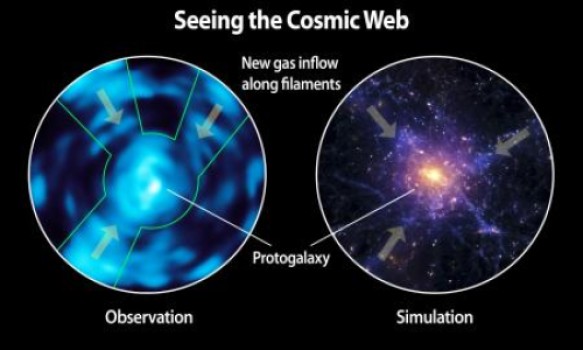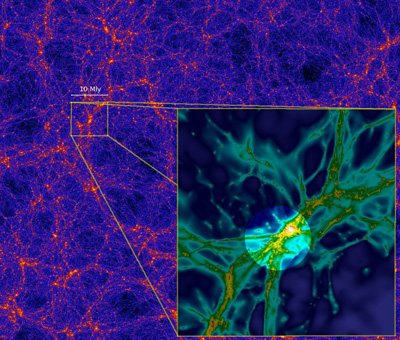The cosmic web unveiled: observing ‘dim matter’ in 3D
May 1, 2014

Comparison of Lyman alpha blob observed with Cosmic Web Imager and a simulation of the cosmic web based on theoretical predictions (credit: Christopher Martin, Robert Hurt)
Caltech astronomers have taken unprecedented 3D images of the intergalactic medium (IGM) — the diffuse gas that connects galaxies throughout the universe, proving that the speculated “dim matter” of the universe exists.
Theoreticians have predicted since the 1980s that primordial gas from the Big Bang is not spread uniformly throughout space, but is instead distributed in channels that span galaxies and flow between them. This “cosmic web” — the IGM — is a network of smaller and larger filaments crisscrossing one another across the vastness of space and back through time to an era when galaxies were first forming and stars were being produced at a rapid rate.
Now, with observations from Caltech’s Cosmic Web Imager, deployed on the Hale 200-inch telescope at Palomar Observatory, astronomers are obtaining our first three-dimensional pictures of the IGM. The Cosmic Web Imager will make possible a new understanding of galactic and intergalactic dynamics, and it has already detected one possible spiral-galaxy-in-the-making that is three times the size of our Milky Way.
The Cosmic Web Imager was conceived and developed by Caltech professor of physics Christopher Martin. “Not only does [IGM] comprise most of the normal matter in the universe, it is also the medium in which galaxies form and grow,” he said.
Martin describes the diffuse gas of the IGM as “dim matter,” to distinguish it from the bright matter of stars and galaxies, and the dark matter and energy that compose most of the universe. It is thought to comprise about 3 percent of everything in the universe.

Computer simulations suggest that matter in the universe is distributed in a “cosmic web” of filaments, as seen in the image above from a large-scale dark-matter simulation (Bolshoi simulation, by Anatoly Klypin and Joel Primack) in a study published in Nature in February 2014. The inset is a zoomed-in, high-resolution image of a smaller part of the cosmic web, 10 million light-years across, from a simulation that includes gas as well as dark matter (credit: S. Cantalupo). The intense radiation from a quasar can, like a flashlight, illuminate part of the surrounding cosmic web (highlighted in the image) and make a filament of gas glow, as was observed in the case of quasar UM287. (Credit: Anatoly Klypin, Joel Primack, S. Cantalupo)
The first cosmic filaments observed by the Cosmic Web Imager are in the vicinity of two very bright objects: a quasar labeled QSO 1549+19 and a so-called Lyman alpha blob in an emerging galaxy cluster known as SSA22.
These objects were chosen by Martin for initial observations because they are bright, lighting up the surrounding IGM and boosting its detectable signal.
Observations show a narrow filament, one million light-years long, flowing into the quasar, perhaps fueling the growth of the galaxy that hosts the quasar. Meanwhile, there are three filaments surrounding the Lyman alpha blob, with a measured spin that shows that the gas from these filaments is flowing into the blob and affecting its dynamics.
Multi-wavelength spectrographic imaging
The Cosmic Web Imager is a spectrographic imager, taking pictures at many different wavelengths simultaneously. This is a powerful technique for investigating astronomical objects, as it makes it possible to not only see these objects but to learn about their composition, mass, and velocity.
Under the conditions expected for cosmic web filaments, hydrogen is the dominant element and emits light at a specific ultraviolet wavelength called Lyman alpha. Earth’s atmosphere blocks light at ultraviolet wavelengths, so one needs to be outside Earth’s atmosphere, observing from a satellite or a high-altitude balloon, to observe the Lyman alpha signal.
However, if the Lyman alpha emission lies much further away from us — that is, it comes to us from an earlier time in the universe — then it arrives at a longer wavelength (a phenomenon known as redshifting). This brings the Lyman alpha signal into the visible spectrum such that it can pass through the atmosphere and be detected by ground-based telescopes like the Cosmic Web Imager.
The objects the Cosmic Web Imager has observed date to approximately 2 billion years after the Big Bang, a time of rapid star formation in galaxies. “In the case of the Lyman alpha blob,” says Martin, “I think we’re looking at a giant protogalactic disk. It’s almost 300,000 light-years in diameter, three times the size of the Milky Way.”
“Our goal is to eventually be able to see the average intergalactic medium everywhere. It’s harder, but we’ll get there,” says Martin.
Two papers describing the initial data from the Cosmic Web Imager have been published in the Astrophysical Journal. The Cosmic Web Imager was funded by grants from the NSF and Caltech.
Abstract of The Astrophysical Journal paper (Intergalactic Medium Emission Observations with the Cosmic Web Imager: I. The Circum-QSO Medium of QSO 1549 19, and Evidence for a Filamentary Gas Inflow)
The Palomar Cosmic Web Imager (PCWI), an integral field spectrograph designed to detect and map low surface brightness emission, has obtained imaging spectroscopic maps of Lyα from the circum-QSO medium (CQM) of QSO HS1549+19 at redshift z = 2.843. Extensive extended emission is detected from the CQM, consistent with fluorescent and pumped Lyα produced by the ionizing and Lyα continuum of the QSO. Many features present in PCWI spectral images match those detected in narrow-band images. Filamentary structures with narrow line profiles are detected in several cases as long as 250-400 kpc. One of these is centered at a velocity redshifted with respect to the systemic velocity, and displays a spatially collimated and kinematically cold line profile increasing in velocity width approaching the QSO. This suggests that the filament gas is infalling onto the QSO, perhaps in a cold accretion flow. Because of the strong ionizing flux, the neutral column density is low, typically  , and the line center optical depth is also low (typically τ0 < 10), insufficient to display well separated double peak emission characteristic of higher line optical depths. With a simple ionization and cloud model we can very roughly estimate the total gas mass (log M gas = 12.5 ± 0.5) and the total (log M tot = 13.3 ± 0.5). We can also calculate a kinematic mass from the total line profile (2 × 1013 M ☉), which agrees with the mass estimated from the gas emission. The intensity-binned spectrum of the CQM shows a progression in kinematic properties consistent with heirarchical structure formation.
, and the line center optical depth is also low (typically τ0 < 10), insufficient to display well separated double peak emission characteristic of higher line optical depths. With a simple ionization and cloud model we can very roughly estimate the total gas mass (log M gas = 12.5 ± 0.5) and the total (log M tot = 13.3 ± 0.5). We can also calculate a kinematic mass from the total line profile (2 × 1013 M ☉), which agrees with the mass estimated from the gas emission. The intensity-binned spectrum of the CQM shows a progression in kinematic properties consistent with heirarchical structure formation.
Abstract of The Astrophysical Journal paper (Intergalactic Medium Emission Observations with the Cosmic Web Imager. II. Discovery of Extended, Kinematically Linked Emission around SSA22 Lyα Blob 2)
The intergalactic medium (IGM) is the dominant reservoir of baryons, delineates the large-scale structure of the universe at low to moderate overdensities, and provides gas from which galaxies form and evolve. Simulations of a cold-dark-matter- (CDM-) dominated universe predict that the IGM is distributed in a cosmic web of filaments and that galaxies should form along and at the intersections of these filaments. While observations of QSO absorption lines and the large-scale distribution of galaxies have confirmed the CDM paradigm, the cosmic web of IGM has never been confirmed by direct imaging. Here we report our observation of the Lyα blob 2 (LAB2) in SSA22 with the Cosmic Web Imager (CWI). This is an integral field spectrograph optimized for low surface brightness, extended emission. With 22 hr of total on- and off-source exposure, CWI has revealed that LAB2 has extended Lyα emission that is organized into azimuthal zones consistent with filaments. We perform numerous tests with simulations and the data to secure the robustness of this result, which relies on data with modest signal-to-noise ratios. We have developed a smoothing algorithm that permits visualization of data cube slices along image or spectral image planes. With both raw and smoothed data cubes we demonstrate that the filaments are kinematically associated with LAB2 and display double-peaked profiles characteristic of optically thick Lyα emission. The flux is 10-20 times brighter than expected for the average emission from the IGM but is consistent with boosted fluorescence from a buried QSO or gravitation cooling radiation. Using simple emission models, we infer a baryon mass in the filaments of at least 1-4 × 1011 M ☉, and the dark halo mass is at least 2 × 1012 M ☉. The spatial-kinematic morphology is more consistent with inflow from the cosmic web than outflow from LAB2, although an outflow feature maybe present at one azimuth. LAB2 and the surrounding gas have significant and coaligned angular momentum, strengthening the case for their association.